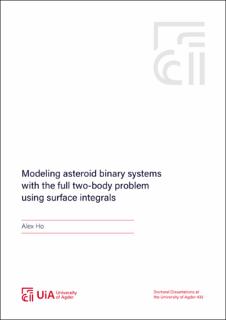| dc.contributor.author | Ho, Alex | |
| dc.date.accessioned | 2023-10-05T11:06:02Z | |
| dc.date.available | 2023-10-05T11:06:02Z | |
| dc.date.created | 2023-10-02T17:50:32Z | |
| dc.date.issued | 2023 | |
| dc.identifier.citation | Ho, Alex (2023). Modeling asteroid binary systems with the full two-body problem using surface integrals [Doctoral dissertation]. University of Agder. | en_US |
| dc.identifier.isbn | 978-82-8427-149-1 | |
| dc.identifier.issn | 1504-9272 | |
| dc.identifier.uri | https://hdl.handle.net/11250/3094453 | |
| dc.description.abstract | An asteroid binary system, where two asteroids are in mutual orbit, is important to study as it can provide knowledge of the history of the asteroid population. The most important mechanism to form asteroid binaries in the near-Earth population, and for asteroids with diameters less than 10 km, is rotational fission. Rotational fission occurs when a rubble pile asteroid, which can be thought of as a collection of rocks held together by gravity, reaches a critical spin rate and the rubble pile starts to shed mass. Studying the dynamics of asteroid binaries allows one to better understand how they have evolved. However, due to their non-spherical shapes, one has to take into account both the translational and rotational motion of asteroids, which is known as the full two-body problem. The study of the full two-body problem is a challenge as the mutual gravitational potential between two non-spherical bodies cannot be expressed analytically. Previous studies have used approximations to model the mutual potential between two asteroids. However, these approximations often suffer from inaccuracies when the bodies are close to each other, and also from truncation errors. In this thesis, we make use of a new method to determine the mutual potential, between two asteroids, with the use of surface integrals. We apply this method to study the dynamics of the 1999 KW4 binary system, where both bodies are modeled as ellipsoids. With the use of an order nine Runge-Kutta method, the system energy and angular momentum are conserved to the 11th decimal digit. One of the advantages of the surface integration method is that the results are valid even if the bodies are close to each other. We make use of this advantage to study the dynamics of asteroid systems formed by rotational fission, as the two bodies are very close to each other in the initial formation stages. We consider ellipsoidal bodies for the simulations. Six models are considered, three where the secondary takes different densities and three where we change the shape of the secondary. The simulations show that more than 80\% of the simulations result in the two bodies colliding. The secondary is more likely to escape the gravitational pull of the primary, forming an asteroid pair, and experience secondary fission, if the secondary has a higher density than the primary, or has a more elongated shape. We also compare the rotation periods of the bodies from the simulations with the ones from observations of asteroid binaries and pairs. The rotation periods from the simulations match very well with the rotation periods of observed asteroid pairs. The surface integration scheme can yield exact values to the mutual gravitational potential between two ellipsoidal bodies. This method can therefore be used to determine the accuracy of methods that approximates the mutual potential between two ellipsoids. We compare the surface integration scheme with an approach that expands the mutual potential with the use of inertia integrals. The differences in the gravitational force and torque, between the two methods, are less than 1\% if the bodies are separated by $2-3$ times the radius of the primary. If the bodies are almost touching, however, the differences can exceed 100\% if the shape of the primary becomes elongated. The discrepancies in the torques are typically an order magnitude larger than the difference in the forces. | en_US |
| dc.language.iso | eng | en_US |
| dc.publisher | University of Agder | en_US |
| dc.relation.ispartof | Doctoral dissertations at University of Agder | |
| dc.relation.ispartofseries | Doctoral Dissertations at the University of Agder; no. 432 | |
| dc.relation.haspart | Paper I: Ho, A., Wold, M., Conway, J. T. & Poursina, M. (2021). Extended two-body problem for rotating rigid bodies, Celestial Mechanics and Dynamical Astronomy, 133, 1-21. https://doi.org/10.1007/s10569-021-10034-8. Published version. Full-text is available in AURA as a separate file. https://hdl.handle.net/11250/2835630. | en_US |
| dc.relation.haspart | Paper II: Ho, A., Wold, M., Poursina, M. & Conway, J. T. (2022). Dynamics of asteroid systems post-rotational fission. Astronomy & Astrophysics, 665(A&A), 14. https://doi.org/10.1051/0004-6361/202243706. Published version. Full-text is available in AURA as a separate file. https://hdl.handle.net/11250/3033631. | en_US |
| dc.relation.haspart | Paper III: Ho, A., Wold, M., Poursina, M. & Conway, J. T. (2023). The accuracy of mutual potential approximations in simulations of binary asteroids. Astronomy & Astrophysics, 671(A&A), 15. https://doi.org/10.1051/0004-6361/202245552. Published version. Full-text is not available in AURA as a separate file. | en_US |
| dc.rights | Attribution-NonCommercial-NoDerivatives 4.0 Internasjonal | * |
| dc.rights.uri | http://creativecommons.org/licenses/by-nc-nd/4.0/deed.no | * |
| dc.title | Modeling asteroid binary systems with the full two-body problem using surface integrals | en_US |
| dc.type | Doctoral thesis | en_US |
| dc.description.version | publishedVersion | en_US |
| dc.rights.holder | © 2023 Alex Ho | en_US |
| dc.subject.nsi | VDP::Teknologi: 500 | en_US |
| dc.source.pagenumber | 200 | en_US |
| dc.source.issue | 432 | en_US |
| dc.identifier.cristin | 2181102 | |




